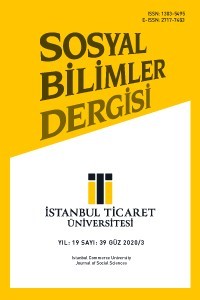YAYIN ÇAĞINDAN SOSYAL YAYIN ÇAĞINA: RİSK YÖNETİMİNDE BİR YAPAY ZEKÂ MODELİ ÖNERİSİ
sosyal medya, itibar yönetimi, risk yönetimi, çevrimiçi itibar yönetimi, yapay zeka
From Broadcasting Era to Socialcasting: An Artificial Intelligence Model in Risk Management
Social media, Risk management, Reputation management, Artificial intelligence, Online reputation management,
___
- 2020 National Customer Rage Study. 17 Mart 2023 tarihinde customercaremc.com: https://customercaremc.com/insights/national-customer-rage-study/2020-national-customer-rage- study/ adresinden alındı.
- Alsop, R. J. (2006). The 18 immutable laws of corporate reputation: Creating, protecting and repairing your most valuable asset. Kogan Page Publishers.
- Argüden, Y. (2002). “Küresel Sorumluluk Anlaşması”, Kurumsal Sosyal Sorumluluk, İstanbul: ARGE Danışmanlık Yayınları, 23-30.
- Baltacı, A. (2018). Nitel Araştırmalarda Örnekleme Yöntemleri ve Örnek Hacmi Sorunsalı Üzerine Kavramsal Bir İnceleme. Bitlis Eren Üniversitesi Sosyal Bilimler Enstitüsü Dergisi, 234-235. Başer, M. (2021). Python. Dikeyeksen Yayın Dağıtım.
- Benthaus, J., Risius, M., ve Beck, R. (2016). Social media management strategies for organizational impression management and their effect on public perception. The Journal of Strategic Information Systems, 25(2), 127-139.
- Bilgi Teknolojileri ve İletişim Kurumu. (2022). “Türkiye Elektronik Haberleşme Sektörü 2022: 3. Çeyrek 3 Aylık Pazar Verileri Raporu.” 7 Mayıs 2023 tarihinde https://www.btk.gov.tr/uploads/pages/pazar-verileri/2022-3-k-disi-3ocak-63f71da4999a3.pdf adresinden alındı.
- Biswas-Diener, R. (2023, Şubat 9). The Three Types of Complaining. Psychology Today: 1 Nisan 2023 tarihinde https://www.psychologytoday.com/us/blog/significant-results/201706/the-three-types- complaining adresinden alındı.
- Cook, S. (2012). Complaint Management Excellence: Creating Customer Loyalty through Service Recovery. Kogan Page.
- Coombs, W. T., ve Holladay, S. J. (1996). Communication and attributions in a crisis: An experimental study in crisis communication. Journal of public relations research, 8(4), 279-295.
- Coombs, W. T., ve Holladay, S. J. (2002). Helping crisis managers protect reputational assets: Initial tests of the situational crisis communication theory. Management communication quarterly, 16(2), 165-186.
- (Çiğdem Penn, 2016). İtibar Algı Modeli: X-Peutation. Yüzyüze görüşme. 09.10.2016 tarihinde.
- DiStaso, M. W., McCorkindale, T., ve Wright, D. K. (2011). How public relations executives perceive and measure the impact of social media in their organizations. Public Relations Review, 325-328.
- Dolphin, R. R. (2004). Corporate reputation–a value creating strategy. Corporate Governance: The international journal of business in society, 4(3), 77-92.
- Edison Research Introduces The Social Habit. (2021). 14 Nisan 2023 tarihinde www.edisonresearch.com: https://www.edisonresearch.com/edison-research-introduces-the-social- habit/ adresinden alındı.
- Fombrun, C., ve Van Riel, C. (2003). The reputational landscape. Revealing the Corporation: Perspectives on identity, image, reputation, corporate branding, and corporate-level marketing, 223- 33.
- Garcia, M. (2023, 02 09). How to Make a Twitter Bot in Python With Tweepy. 3 Nisan 2023 tarihinde www.realpython.com: https://realpython.com/twitter-bot-python tweepy/#:~:text=Tweepy%20is%20an%20open%20source,Data%20encoding%20and%20decoding adresinden alındı.
- Gibson, D., Gonzales, J. L., ve Castanon, J. (2006). The importance of reputation and the role of public relations. Public relations quarterly, 51(3), 15.
- Kılınç, U. (2011). Şikayet Yönetimi: Müşteri İşgören Etkileşiminde Sözsüz İletişim (Doktora Tezi). Adnan Menderes Üniversitesi, Sosyal Bilimler Enstitüsü, Aydın., 15.
- Klein, J., ve Dawar, N. (2004). Corporate social responsibility and consumers' attributions and brand evaluations in a product–harm crisis. International Journal of research in Marketing, 21(3), 203-217.
- Klewes, J., ve Wreschniok, R. (2009). Reputation capital Building and maintaining trust in the 21st century. In Reputation Capital: Building and Maintaining Trust in the 21st Century (pp. 1-8). Berlin, Heidelberg: Springer Berlin Heidelberg.
- Lincoln, A. Character is like a tree and reputation like a shadow. The shadow is what we think of it; The tree is the real thing. 17 Nisan 2023 tarihinde https://www.brainyquote.com/quotes/abraham_lincoln_121094 adresinden alındı.
- Maheswaran, D., Mackie, D. M., ve Chaiken, S. (1992). Brand name as a heuristic cue: The effects of task importance and expectancy confirmation on consumer judgments. Journal of consumer psychology, 1(4), 317-336.
- Natural Language Toolkit (2022). 23.03.2023 tarihinde nltk.org: https://www.nltk.org/ adresinden alındı.
- Niu , R. H., ve Fan , Y. (2016, Eylül 5). To tweet or not to tweet? Exploring the effectiveness of service recovery strategies using social media. International Journal of Operations ve Production Management, s. 1014-1036.
- Peppers, D., ve Rogers, M. (2004). Managing Customer Relationships. Wiley.
- ReputationX. (28 Ocak, 2023). “How to avoid the corporate pitfalls of reputational risk” 10.04.2023 tarihinde reputationx.com adresinden alındı.
- ReputationX. (29 Ağustos, 2022). “What makes corporate reputation a valuable intangible asset?”. 10.04.2023 tarihinde reputationx.com adresinden alındı.
- ReputationX. (6 Eylül, 2022). “All about the reputation quotient model”. 10.04.2023 tarihinde reputationx.com adresinden alındı.
- Roulin, N., ve Levashina, J. (2016). Impression management and social media profiles. Social media in employee selection and recruitment: Theory, practice, and current challenges, 223-248.
- Sabuncuoğlu, Z., ve Tüz, M. (19988). Örgütsel Psikoloji. 3. baskı Alfa Basın Yayın Ltd Şti.
- Thiraviyam, T. (2018). Artificial intelligence Marketing. 20-25.
- Vollenbroek, W., De Vries, S., Constantinides, E., ve Kommers, P. (2014). Identification of influence in social media communities. International Journal of Web Based Communities 4, 10(3), 280-297.
- What Is Pandas In Python? Everything You Need To Know. (2023). 15 Nisan 2023 tarihinde www.activestate.com: https://www.activestate.com/resources/quick-reads/what-is-pandas-in-python- everything-you-need-to-know/ adresinden alındı.
- ISSN: 1303-5495
- Yayın Aralığı: Yılda 3 Sayı
- Başlangıç: 2002
- Yayıncı: İstanbul Ticaret Üniversitesi
Mevlüt CAMGÖZ, Sümeyye YILMAZTÜRK
Duygusal Yemenin Yordayıcısı Olarak Yalnızlık ve Olumsuz Beden Konuşmalarının İncelenmesi
Süleyman KAHRAMAN, Hande NUSEL
TÜRKİYE SAĞLIK SİSTEMİNİN DÖNÜŞÜMÜ (2003-13): TIBBİ TEKNOLOJİNİN YAYILIMI
eTWINNING PROJE ÇALIŞMALARININ ÖĞRETMENLERİN BİRLİKTE ÇALIŞMA YETERLİLİKLERİNE ETKİSİ
VARDİYALI ÇALIŞMANIN İŞE BAĞLILIK VE İŞ PERFORMANSINA ETKİSİ
Yaşare ULUKAN, Şükriye KILIÇ AKSOY, Hüseyin ÇİÇEK
COVID-19 SÜRECİNDE HELİKOPTER PARA ÇÖZÜM MÜ?
Masoud SHEIKHI, Rana ATABAY KUŞÇU
FED FAİZ KARARLARININ ÜLKELER ÜZERİNDEKİ FİNANSAL ETKİLERİNİN İNCELENMESİ
Özel Öğretim Kurumlarında Kurumsallaşmaya İlişkin Okul Müdürlerinin Görüşleri
